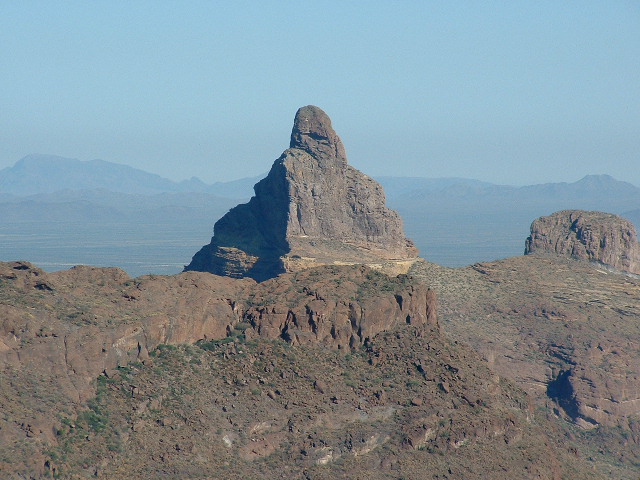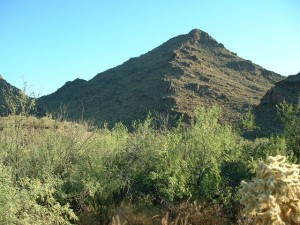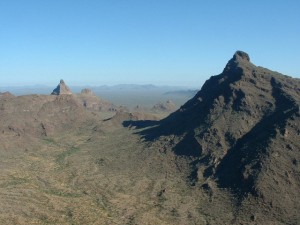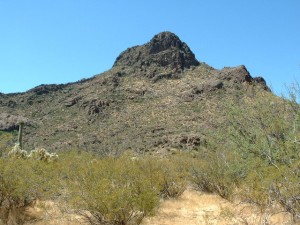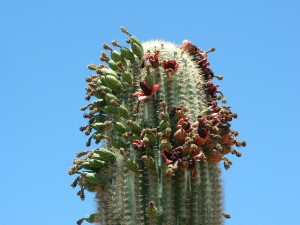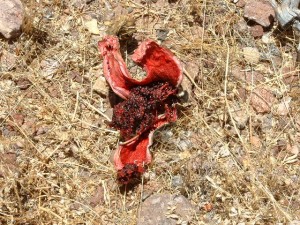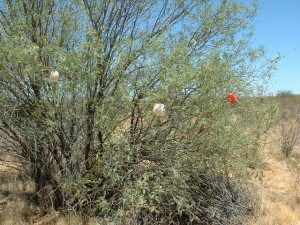This story was written one hot June a few years ago. It seems appropriate to share with you now, as the summer heat has returned in earnest.
During the month of June, I wasn’t able to get away from town and go climbing. Work on a new construction project had begun, taking up much of my time. But finally, on Sunday the 26th, I decided to go for it. June is our hottest month, and this year it had been particularly hot, reaching 110 degrees on two consecutive days and as much as 107 and 108 several other times. In and of itself, the heat is quite daunting. People are out there dying in it every day. It rarely takes later than 12:00 noon to reach 100 degrees.
I arose at 2:30 a.m. and drove across the reservation in the dark. At one point I kept nodding off, so I pulled off the pavement and closed my eyes for a while. By the time I arrived at Barajita Well on the east side of the Ajo Range and got my pack ready, it was 7:00 a.m. This was a pretty late time to be starting, as I had lost over two hours of useable daylight and it was already getting hot.
I noticed that the man-made tank near the well was dry. I imagine most of these watering holes on the reservation are dry by now. This has got to be very hard on cattle and other creatures living out there. The monsoon rains usually start by July 7th on average, and I hope they are plentiful this year. Three years ago the rains were so sparse that thousands of cattle on the reservation died of thirst – I found their bodies everywhere I went.
I headed north from the well, staying on the west slopes of Peak 3542. The mountain is so steep that, as late in the day as it was, I was able to do the whole climb in the shade. That was a relief. I was about 500 feet below the summit, climbing steadily and deep in thought, when I got quite a start. I was on a steep slope, using both hands and feet for purchase, when, about two feet in front of my face, the unmistakable sound of a rattlesnake suddenly erupted. It scared the daylights out of me. It was a small snake, maybe only two feet long, but when I heard it I let out a yelp and backed away, giving it a wide berth. I can tell you that I was much more alert during the rest of the climb! Once on top of Peak 3542, I enjoyed the views. Peak 4088 (“Montezuma Peak”) is immediately to the north and it takes your breath away. Just seeing it makes climbing anywhere in this area worthwhile. I called my wife on my cell phone to report my position and update her on my plans for the rest of the day’s climbing. One can’t be too cautious out here, especially when climbing solo in the heat.
I descended the west ridge of the peak. Rough terrain forced me to a point about 75 feet below the saddle with the neighboring peak to the west. From there, I started up Peak 3340, my next objective, in the full sunlight. It was getting hot. Fortunately, It didn’t take long to reach the summit. I called my wife once more, then started down the sharp south ridge. I went slowly and carefully, keeping my wits about me so as not to take a spill, and finally made it back to the truck. Three hours had passed since I left, and it was about 10:00 a.m.
I had a cooler filled with ice-cold drinks at the truck, and I drank all I could to rehydrate. I was still feeling pretty good. There was one more mountain I wanted to climb, since I was so close, so I drove a bit further west and parked just off the road. I was tempted to not take a pack with me but I decided against it. I knew I should carry as much water as possible and not tempt fate. If for some reason I was forced to spend the night out and had run out of water, I’d be in trouble. I headed due south on foot, crossing Kuakatch Wash and then several hundred yards of easy ground. The northeast side of Peak 3137 looked do-able. A few cliff bands would force me to do some route-finding, but I thought I saw a way through. Sure enough, a stiff Class 3 route presented itself. I marked my line of ascent with a series of little rock piles through the cliff bands, and before I knew it I was on top. This summit, like the others I had climbed today, showed no sign of any previous visit, so I built my third cairn of the day and left one of my climbing registers in it. I descended the same way and was glad to be back on flatter ground. Even though this climb involves barely a mile of travel on foot, it took an hour and a half to complete and get back to the truck. And now it was hot! 105 degrees.
I always wear a headband to keep the sweat from running into my eyes in hotter weather, and I change into a complete set of clean clothes back at the truck when the last climb is done. I tanked up, and brought a few more cold drinks with me in the cab of the truck. I cranked the air conditioner up to maximum, and drove back out. In well over 30 miles of driving the dirt roads this day in the northern Gu Vo district, once again I didn’t see a soul. That suited me just fine. I was back in Tucson by 3:30 p.m.
I have attached a few pictures from this climb.
1. From the summit of Peak 3542, the first of the day, here is a shot of Montezuma Head (on the left) and Peak 4088 (“Montezuma Peak”, on the right). We are looking NNW. A tributary of Kuakatch Wash runs away from us in the valley below. Peak 4088 sits astride the reservation boundary, while Montezuma Head is entirely within Organ Pipe Cactus National Monument. Climbers doing the list of Arizona’s peaks with 1,000 feet of prominence will have to climb both of these.
2. This is Peak 3137, seen from the northeast where I parked. It was already over 100 degrees.
3. The saguaro cactus blossoms produce fruit during the month of June. This is an important time in the spiritual calendar of the O’odham people. So much so that the month of June in the O’odham language is called “Hahshani Bahithag Mashath” which means “the saguaro cactus fruit month”. Although not done so much now as in the past, the fruit is gathered by the people and boiled down to make wine and jam. I still run across the rare camp where in June the people will gather the fruit and boil it down. I passed such a place the day of this climb. Each cactus can produce hundreds of fruits in June.
4. When ripe, the fruit falls to the ground. Each one contains a jammy substance filled with hundreds of seeds. Birds and other creatures eat the fruit, then widely disperse the seeds when they excrete them. They say one saguaro cactus can produce millions of seeds in its long lifetime, often 250 years. Even so, each cactus will be lucky to produce one offspring which will grow to maturity.
5. As I was driving along the dirt road known as Indian Highway 1, the “back way” into the Gu Vo district, I saw this tree which had been decorated with silk flowers. I counted seven of them. An unexpected colorful surprise in this harsh land.
Please visit our Facebook page at https://www.facebook.com/pages/Desert-Mountaineer/192730747542690

